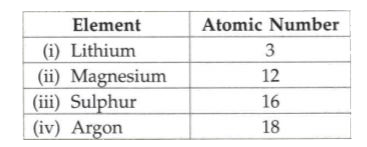Define - Valency
Step-by-Step Solution:
1. Understanding Valency:
- Valency is defined as the combining power of an element. It indicates how many atoms of another element an atom can bond with.
2. Relation to Electrons:
- Valency is related to the electrons in the outer shell of an atom. Specifically, it refers to the number of electrons that need to be added or lost for an atom to achieve a stable electronic configuration, often resembling that of noble gases.
3. Octet Rule:
- The octet rule states that atoms tend to gain, lose, or share electrons to achieve a full outer shell of eight electrons, which is considered stable.
4. Example of Chlorine:
- Taking chlorine as an example, it has an atomic number of 17, which means it has 17 electrons. Its electronic configuration is 1s² 2s² 2p⁶ 3s² 3p⁵.
- In the outermost shell (the third shell), chlorine has 7 electrons.
5. Determining Valency of Chlorine:
- To achieve the octet (8 electrons), chlorine needs to gain 1 more electron. Therefore, the valency of chlorine is 1.
- This means chlorine can combine with other elements by either gaining this one electron (in ionic bonds) or sharing its electrons (in covalent bonds).
6. Conclusion:
- Thus, valency is a crucial concept in chemistry that helps us understand how different elements interact and bond with each other.
---
- Valency is defined as the combining power of an element. It indicates how many atoms of another element an atom can bond with.
- Valency is related to the electrons in the outer shell of an atom. Specifically, it refers to the number of electrons that need to be added or lost for an atom to achieve a stable electronic configuration, often resembling that of noble gases.
- The octet rule states that atoms tend to gain, lose, or share electrons to achieve a full outer shell of eight electrons, which is considered stable.
- Taking chlorine as an example, it has an atomic number of 17, which means it has 17 electrons. Its electronic configuration is 1s² 2s² 2p⁶ 3s² 3p⁵.
- In the outermost shell (the third shell), chlorine has 7 electrons.
- To achieve the octet (8 electrons), chlorine needs to gain 1 more electron. Therefore, the valency of chlorine is 1.
- This means chlorine can combine with other elements by either gaining this one electron (in ionic bonds) or sharing its electrons (in covalent bonds).
- Thus, valency is a crucial concept in chemistry that helps us understand how different elements interact and bond with each other.
Topper's Solved these Questions
- LANGUAGE OF CHEMISTRY BOOK - ICSECHAPTER - LANGUAGE OF CHEMISTRY EXERCISE - Exercise (Write chemical equations in symbols and formulae for the following word equations)
4 Videos
- LANGUAGE OF CHEMISTRY BOOK - ICSECHAPTER - LANGUAGE OF CHEMISTRY EXERCISE - Exercise (Answer the following in short)
8 Videos
- LANGUAGE OF CHEMISTRY BOOK - ICSECHAPTER - LANGUAGE OF CHEMISTRY EXERCISE - Exercise (Write the names of the compounds represented by the following formulae)
5 Videos
- HYDROGEN BOOK - ICSECHAPTER - HYDROGEN EXERCISE - Think and answer
3 Videos
- MATTERBOOK - ICSECHAPTER - MATTEREXERCISE - EXERCISE (J. Short answer questions)
5 Videos
Similar Questions
In CH4, valency of carbon is four . Valency of carbon in acetylene is .
View SolutionFind the valency if Chlorine.
View SolutionWhich of the following has valency 4 ?
View SolutionValency is the number of hydrogen atoms which can combine with (or displace) one atom of the element (or radical] forming a compound'. With reference to the above definition of valency, state the valency of chlorine in hydrogen chloride, giving reasons.
View SolutionWrite the electronic configuration and valency of the following elements.

View SolutionWrite the valency of each atom in CO2
View SolutionDefine the following terms :
(a) Atoms
(b) Molecules
(c) Radicals
(d) Valency
(e) Periodic table
View Solution(a) Define the following terms:
(i) Valency, (ii) Atomic size
(b) How do the valency and the atomic size of the element vary while going from left to right along a period in the modern periodic table?
View SolutionDefine the term valcney. With reference to water and ammonia as compounds respectively, state the valency of oxygen & nitrogen. Magnesium [2,8,2] has valency 2+. Give reasons.
View SolutionElement X is a metal with a valency 2, Y is a non metal with a valency 3.
View Solution
